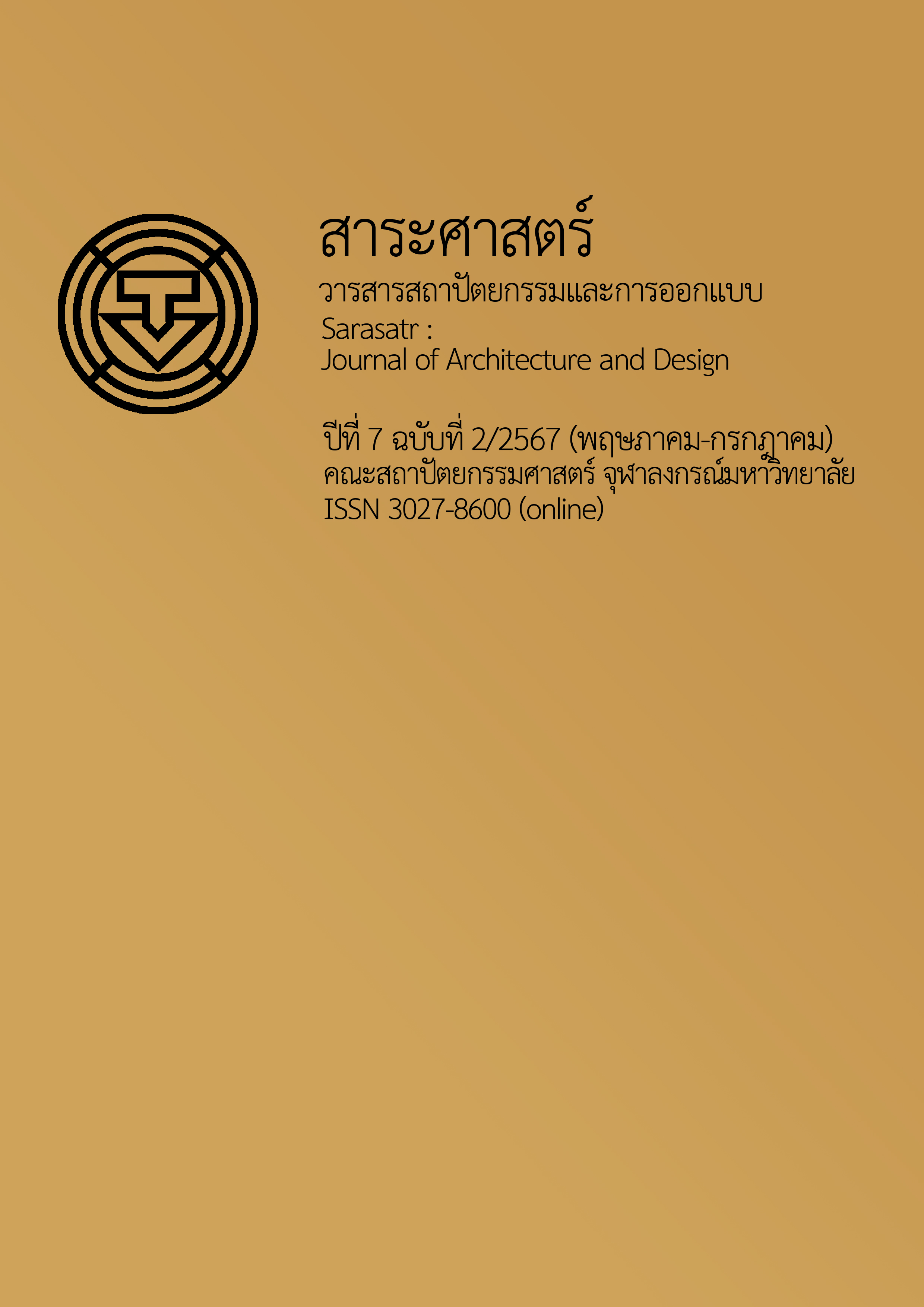แนวทางการพัฒนาสภาพแวดล้อมภายนอกสำหรับผู้สูงอายุ กรณีศึกษา ชุมชนคลองพลับพลา ชุมชนทรัพย์สินใหม่ ชุมชนเลิศสุขสม และชุมชนบึงยี่โถ
Main Article Content
บทคัดย่อ
โครงสร้างประชากรของประเทศไทยเข้าสู่การเป็น “สังคมสูงวัย” ตั้งแต่ พ.ศ. 2548 กล่าวคือ มีสัดส่วนประชากรอายุ 60 ปีขึ้นไปสูงถึงร้อยละ 10 ของประชากรทั้งหมด โดยใน พ.ศ. 2565 ประชากรไทยมีสัดส่วนผู้สูงอายุกว่าร้อยละ 18.94 ของประชากรทั้งหมด และในอีกไม่เกิน 20 ปี ประชากรผู้สูงอายุจะเพิ่มขึ้นอีกเท่าตัว จึงเป็นสัญญาณบ่งชี้ว่าผู้สูงอายุจะกลายเป็นประชากรส่วนใหญ่ของประเทศ แต่ประเทศไทยยังขาดการรับมือกับสถานการณ์ดังกล่าวอย่างครอบคลุม โดยเฉพาะการพัฒนาสภาพแวดล้อมภายนอกอาคารที่ซึ่งเป็นพื้นที่ทางสังคมที่ทำให้คนในชุมชนได้มาปฏิสัมพันธ์กัน การที่หลายชุมชนยังขาดพื้นที่ดังกล่าวหรือจัดการพื้นที่ได้ไม่เหมาะสมกับผู้สูงอายุ ส่งผลให้ผู้สูงอายุไม่ออกมาทำกิจกรรมนอกบ้าน เกิดความเสี่ยงต่อการแยกตัวจากสังคมและนำไปสู่ปัญหาทางจิตใจของผู้สูงอายุในเวลาต่อมา การพัฒนาพื้นที่เหล่านี้จะช่วยเปิดโอกาสให้ผู้สูงอายุมีพื้นที่พักผ่อนหย่อนใจ พบปะสังสรรค์ มีกิจกรรมที่สร้างเสริมสุขภาพและความสัมพันธ์ในชุมชน เป็นสิ่งสำคัญที่จะช่วยสร้างเสริมสุขภาพทางกายและทางใจของผู้สูงอายุ จึงเป็นที่มาของงานวิจัยฉบับนี้ที่เป็นงานวิจัยแบบผสมผสานประกอบด้วยการวิจัยเชิงคุณภาพด้วยการสำรวจและการสัมภาษณ์ และการวิจัยเชิงปริมาณด้วยการสัมภาษณ์ มีวัตถุประสงค์ในการศึกษาแนวคิด ทฤษฎีที่เกี่ยวข้องกับการพัฒนาสภาพแวดล้อมภายนอกที่เหมาะสมสำหรับผู้สูงอายุ วิเคราะห์ความต้องการ ปัญหา และข้อจำกัด พร้อมนำเสนอแนวทางการพัฒนาพื้นที่ โดยมีกรณีศึกษาทั้งหมด 4 พื้นที่ ได้แก่ ชุมชนคลองพลับพลา ชุมชนทรัพย์สินใหม่ ชุมชนเลิศสุขสม และชุมชนบึงยี่โถ (หมู่บ้านปิยวรารมย์) ผลการศึกษาพบว่า ทุกชุมชนมีการพัฒนาสภาพแวดล้อมภายนอกสำหรับผู้สูงอายุ โดยสามารถจำแนกพื้นที่ตามรูปแบบการใช้งานได้ 4 ประเภท ได้แก่ พื้นที่นันทนาการ พื้นที่ออกกำลังกาย พื้นที่พักผ่อน และพื้นที่แปลงผักสวนครัว โดยพื้นที่แต่ละประเภทมักตั้งอยู่รวมกันบริเวณส่วนหน้าถึงส่วนกลางของชุมชนที่สามารถเข้าถึงได้โดยง่าย ทั้งนี้ บางชุมชนอาจจะมีการกระจายพื้นที่แต่ละประเภททั่วชุมชน ผลคือ ชุมชนต้องใช้งบประมาณมากขึ้นในการดูแลรักษาและไม่สามารถดูแลได้อย่างทั่วถึง นอกจากนี้ปัญหาหลัก ๆ ของแต่ละชุมชนคือ พื้นที่บางส่วนมีความทรุดโทรม ขาดร่มเงา บางส่วนถูกทิ้งร้างเนื่องจากขาดงบประมาณและการดูแลรักษา จึงเสนอให้จัดตำแหน่งของพื้นที่ส่วนกลางรวมอยู่จุดเดียวเพื่อลดภาระในการดูแลรักษา กำหนดเวลาเปิดปิดพื้นที่ที่มีทรัพย์สินของชุมชนและมอบหมายคนดูแล เพิ่มม้านั่งแบบถาวรพร้อมราวพยุงตัวในพื้นที่ส่วนกลางและทางเดิน จัดการพื้นที่ทางเท้าให้ปลอดภัย และเพิ่มร่มเงาจากต้นไม้
Article Details
เอกสารอ้างอิง
กรมอนามัย. สำนักอนามัยสิ่งแวดล้อม. (2558). การจัดสภาพแวดล้อมที่เหมาะสมกับผู้สูงอายุ. https://env.anamai.moph.go.th/web-upload/11xc410600758f76a9b83604e779b2d1de5/202012/m_news/32675/199758/file_download/d0f723e71c6b37674431139975377c2e.pdf
กรมอนามัย. สำนักอนามัยผู้สูงอายุ. (2565). รายงานสถานการณ์ผู้สูงอายุประจำปี 2565. สำนัก.
กระทรวงการพัฒนาสังคมและความมั่นคงของมนุษย์. (2547). พระราชบัญญัติผู้สูงอายุ พ.ศ. 2546. เจเอสการพิมพ์.
ไตรรัตน์ จารุทัศน์. (2561). การออกแบบเพื่อทุกคน Universal Design. โรงพิมพ์แห่งจุฬาลงกรณ์มหาวิทยาลัย.
Bangkokcitimart. (2561). แนวคิดการออกแบบที่อยู่อาศัยเพื่อผู้สูงอายุ. https://www.bkkcitismart.com/บทความ/20-feb-2018/ออกแบบที่อยู่-เพื่อผู้สูงอายุ2
ภาวดี อังศุสิงห์. (2565, มกราคม-มิถุนายน). สภาพแวดล้อมนอกอาคารที่เหมาะสมสำหรับผู้สูงอายุในชุมชนเมืองน่าอยู่กรุงเทพมหานคร. หน้าจั่ว ว่าด้วยประวัติศาสตร์สถาปัตยกรรมและสถาปัตยกรรมไทย, 19(1), 316-353.
มูลนิธิสถาบันวิจัยและพัฒนาผู้สูงอายุไทย. (2564). สำรวจเทรนด์โลก “Aging in Place สูงวัยในที่เดิม ความท้าทายที่ไทยต้องเผชิญ. https://thaitgri.org/?p=39983
ลภา เฉลยจรรยา. (2560). แนวทางการออกแบบปรับปรุงที่อยู่อาศัย อาคาร และพื้นที่ภายนอกสำหรับผู้สูงอายุในเขตพื้นที่ชานเมือง กรณีศึกษาพื้นที่เขตเทศบาลเมืองบึงยี่โถ จังหวัดปทุมธานี [วิทยานิพนธ์ปริญญามหาบัณฑิต ไม่ได้ตีพิมพ์].จุฬาลงกรณ์มหาวิทยาลัย.
เวณิกา ธูปพลทัพ. (2560). แนวทางการออกแบบปรับปรุงที่อยู่อาศัย อาคาร และพื้นที่ภายนอกสำหรับผู้สูงอายุเขตชุมชนเมืองในพื้นที่สำนักงานทรัพย์สินส่วนพระมหากษัตริย์ กรณีศึกษา ชุมชนทรัพย์สินใหม่ ชุมชนทรัพย์สินเก่า และชุมชนคลองพลับพลา เขตวังทองหลาง กรุงเทพมหานคร [วิทยานิพนธ์ปริญญามหาบัณฑิตไม่ได้ตีพิมพ์]. จุฬาลงกรณ์มหาวิทยาลัย.
สำนักงานคณะกรรมการพัฒนาการเศรษฐกิจและสังคมแห่งชาติ. (2556). การคาดประมาณประชากรของประเทศไทย พ.ศ. 2553-2583. สำนัก.
Baquero Larriva, M. T. (2020, December). Health risk for older adults in Madrid, by outdoor thermal and acoustic comfort. Urban Climate, 34, 100724.
Burton, E., & Mitchell, L. (2006). Inclusive urban design: Streets for life. Routledge.
CEUD. (n.d.). About universal design. The Centre for Excellence in Universal Design. https://universaldesign.ie/what-is-universal-design/
Delagran, L. (n.d.). What is community wellbeing. https://www.takingcharge.csh.umn.edu/what-community-wellbeing
Doty, P. (1996). Caring for frail elderly people: Policies in evolution. Office of the Assistant Secretary for Planning and Evaluation, U.S. Department of Health and Human Services.
Iecovich, E. (2014). Aging in place: From theory to practice. Anthropological Notebooks, 20(1), 21-32.
Lawton, M. P. (1983). Environment and other determinants of well-being in older people 1. The Gerontologist, 23(4), 349-357. https://doi.org/10.1093/geront/23.4.349
OECD. (2002). Aging, housing and urban development. https://doi.org/doi:https://doi.org/10.1787/9789264176102-en
Othman, A. R., & Fadzil, F. (2015). Influence of outdoor space to the elderly wellbeing in a typical care centre. Elsevier.
Wang, Z., Shepley, M. M., & Rodiek, S. D. (2012). Aging in place at home through environmental support of physical activity: An interdisciplinary conceptual framework and analysis. Journal of Housing for the Elderly, 26(4), 338-354. https://doi.org/10.1080/02763893.2011.625289
Whatworkswellbeing. (2017). What is community wellbeing? https://whatworkswellbeing.org/resources/what-is-community-wellbeing-conceptual-review/
World Health Organization. (n.d.). Definition of an older or elderly person. https://www.scribd.com/document/190077600/WHO-Definition-of-an-Older-or-Elderly-Person
World Health Organization. (n.d.). The WHO age-friendly cities framework. https://extranet.who.int/agefriendlyworld/age-friendly-cities-framework/
World Health Organization. (2022). Age-friendly environment. https://www.who.int/teams/social-determinants-of-health/demographic-change-and-healthy-ageing/age-friendly-environments
World Health Organization. (2023). National programmes for age-friendly cities and communities: A guide. https://www.who.int/publications/i/item/9789240068698


